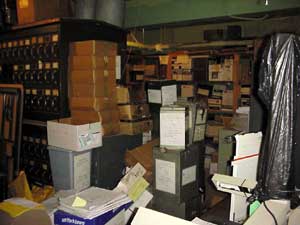 |
|
West Basement |
[Master Plan] [Introduction] [Development] [Timeline] [Existing Conditions] [Recommendations] [Bibliography]
| Master Plan For | |||
| The Restoration Of | |||
| The Dimmit County Courthouse | |||
Note that the basement consists of two rooms.
| Floor: | Concrete |
| Walls: | Plaster |
| Ceiling: | Concrete |
| Lighting: | No lighting with the exception of the electrical closet |
| Enclosed Stairs: | Concrete |
| Architectural Features: | None |
| Interior Doors/Hardware: | Hollow wood door to stairs |
| Windows: | None |
| Furnishings: | Contemporary wood shelving |
The east basement is located at the southeast corner of the building under the stairway and contains approximately 150 square feet. It originally housed the courthouse boiler and currently contains the newly added service distribution electrical panels and the machine room for the elevator. Water is entering this section of the basement, possibly from the original boiler flue located on the south wall. The plaster walls are in poor condition due to moist conditions. Adequate lighting in the area is needed for access to electrical service distribution panels and to prevent falls on steep stairs. Inadequate lighting precluded photography of this area.
 |
|
West Basement |
| Floor: | Concrete |
| Walls: | Plaster |
| Lighting: | Four surface mounted fixtures |
| Open Stairs: | Concrete steps with pipe railing banister |
| Architectural Features: | None |
| Interior Doors/Hardware: | Hollow wood door |
| Windows: | None |
| Furnishings: | Contemporary wood shelving |
The west basement, located directly under the County Clerk’s office (Room 116), is used to store County Clerk’s records. Accessed from the County Clerk’s office, it contains 150 square feet. There exists evidence of excessive moisture and sweating from exposed pipes which has affected the plaster walls and damaged some county records. These pipes appear to be wrapped with asbestos insulation.
 |
|
Secretary’s Office, Room 100 |
| Room 100: | Secretary’s Office (County Judge’s Suite) |
| Floor: | Terrazzo flooring with terrazzo base moulding |
| Walls: | Plaster |
| Ceiling: | Suspended 2’ x 4’ acoustical tile |
| Lighting: | One surface mounted fluorescent fixture |
| Architectural Features: | Original crown moulding above suspended ceiling |
| Interior Doors/Hardware: | Door leading into secretary’s office is wood panel (1926) with original hardware. Door leading into Commissioners Courtroom is wood and glass panel (1926) with non historic hardware. Door leading into Judge’s office is non-historic (1956). |
| Windows: | See exterior window assessment, page 47 (Window Type A) |
| Furnishings: | Three antique chairs |
The County Judge’s suite is accessed from the corridor behind the stairs and contains approximately 395 square feet comprising two offices. The County Judge Secretary’s office consists of the secretary’s work station and desk, computer work area and filing cabinets with a small waiting area. The office contains two interior doors, one of which leads to the County Judge’s office and the other into the Commissioners Courtroom (currently blocked by storage cabinets). The non-historic terrazzo floor was added in 1960. The interior is in good condition except for windows.
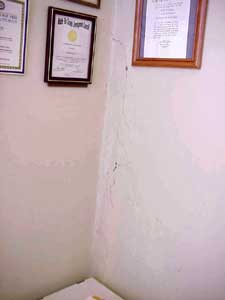 |
|
Detail of southwest wall, Room 101 |
| Room 101: | County Judge’s Office (County Judge’s Suite) |
| Floor: | Terrazzo flooring with terrazzo base moulding |
| Walls: | Plaster Ceiling: Original plaster ceiling |
| Lighting: | One stem-mounted fluorescent lighting fixture |
| Architectural Features: | Original crown moulding |
| Interior Doors/Hardware: | Door leading into Commissioners Court is wood panel (1926) with original hardware |
| Windows: | See window assessment (Window Type A) |
| Furnishings: | Judge’s desk, credenza with computer, antique book shelves |
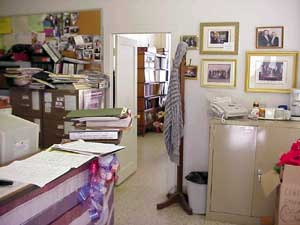 |
|
Looking into judge’s office, Room 101 |
Windows, especially on the south elevation, are in bad condition (Window Type A) and present a serious security risk. The window sash is rotted from water infiltration and termite damage with the glazing in danger of falling out. The plaster walls are in poor condition with numerous cracks. Terrazzo flooring is non-historic (1960). An interior door leads directly from this office into the Commissioners Courtroom.
| Room 102: | County Commissioners Courtroom |
| Floor: | Terrazzo flooring with terrazzo base moulding |
| Walls: | Plaster |
| Ceiling: | Original plaster ceiling |
| Lighting: | Two stem-mounted fluorescent lighting fixture |
| Architectural Features: | Original crown moulding |
| Interior Doors/Hardware: | Door leading to corridor is wood and glass panel door with transom, no hardware |
| Windows: | See window assessment (Window Type A) |
| Furnishings: | Non historic commissioners table and chairs, side desk, podium, antique bookcase (1884) |
The Commissioners Courtroom is accessed from the main hallway with an interior doorway leading directly into the County Judge’s office. Containing only approximately 543 square feet, the room is inadequate for public meetings. A long table serves as a dais for commissioners with an additional table for county officials and a small desk for the county clerk. Seating for the public is limited to approximately twelve chairs which is wholly inadequate. The acoustics of the room make recording meetings very difficult. Plaster walls are in poor condition. The non-historic terrazzo floor was added in 1960. A tall bookcase on the south wall dates from the 1884 original courthouse and is one of the few remaining pieces of furniture from this period.
 |
|
County Commissioners Courtroom, Room 102 |
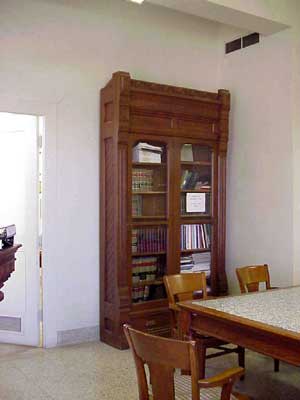 |
|
Antique furniture in Room 102 |
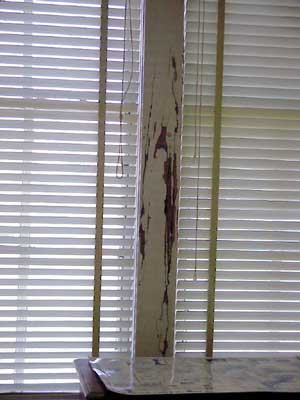 |
|
Detail of window, Room 102 |
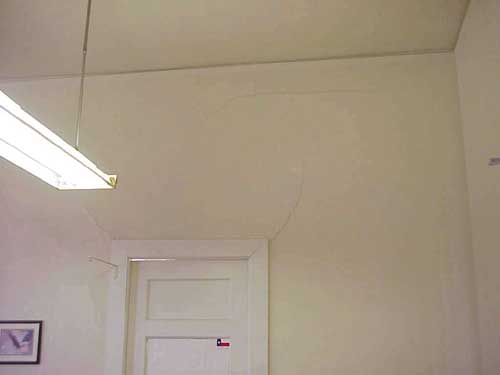 |
|
Cracked plaster, Room 102 |
 |
|
Detail of county vault door, Room 103 |
| Room 103: | County Vault |
| Floor: | Concrete floor |
| Walls: | Fastened 3’ x 9’ steel panels (1884) |
| Ceiling: | Fastened 3’ x 9’ steel panels (1884) |
| Lighting: | One stem-mounted fluorescent lighting fixture |
| Architectural Features: | Enclosed during the 1926 construction |
| Interior Doors/Hardware: | Steel frame and vault door (1884) |
| Windows: | None |
| Furnishings: | Storage shelves (wood framing members) |
This vault, originally constructed for the 1884 courthouse, is accessed only through the adjacent storage room. Containing approximately 96 square feet, storage shelves contain most of the earliest deed records for the county. The vault is an important feature from the original construction period and is in good condition, although its small size is inadequate for today’s record storage needs.
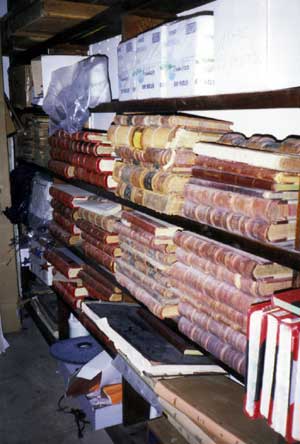 |
|
Detail of county vault, Room 103 |
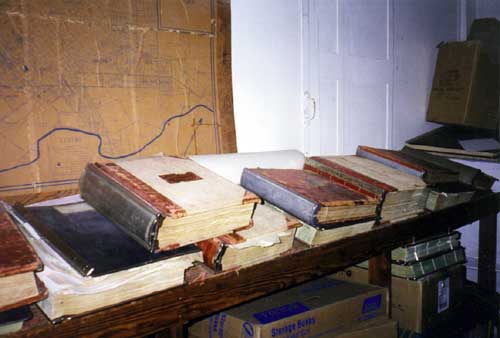 |
|
Detail of county vault, Room 103 |
 |
|
Detail of storage, Room 104 |
| Room 104: | Storage |
| Floor: | Terrazzo flooring with terrazzo base moulding |
| Walls: | Original plaster walls |
| Ceiling: | Original plaster ceiling |
| Lighting: | One stem-mounted fluorescent lighting fixture |
| Architectural Features: | Original crown moulding |
| Interior Doors/Hardware: | Door leading to corridor is wood panel with transom (covered up) and non- historic hardware (lever) |
| Windows: | See window assessment (Window Type A). Windows are covered with cardboard. |
| Furnishings: | Storage shelves (wood framing members) |
This storage area is accessed both from the main corridor and the adjacent Justice of the Peace’s office. It originally served as an office and contains approximately 169 square feet. Three walls are covered with wood storage shelving extending the entire height of the sixteen foot ceiling, making it both difficult and dangerous to access records stored on the top shelves. The main telephone switchboard is located within this room. In addition to record storage, the room contains cleaning supplies and an old, but functioning, refrigerator which could present a fire hazard to the records.
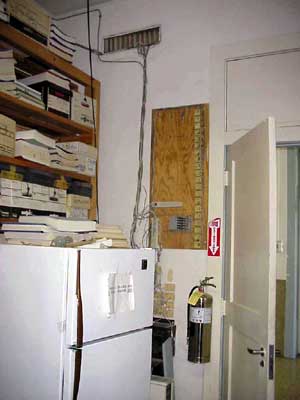 |
|
Detail of storage, Room 104 |
[Master Plan] [Introduction] [Development] [Timeline] [Existing Conditions] [Recommendations] [Bibliography]